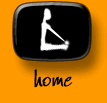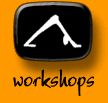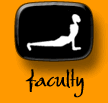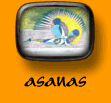

 |
 |
 |
 |
 |
 |
|
DOWNDOG | EAGLE | COBRA | HERO | HALF MOON | CORPSE | GATE
TRIANGLE | PEACOCK | LOCUST | COBBLER | SHOULDER STAND HEADSTAND | BRIDGE | CAMEL | COW FACE | UP BOW | INVERTED STAFF SEATED WIDE ANGLE | HEAD TO KNEE | TORTOISE | DANCER NOOSE  |
| Baddha Konasana ~ Bound Angle Pose / Cobbler Pose Images by Nancy Van Kanegan Sitting on your mat, bring the soles of your feet together and draw the heels in close to the pelvis. If you're stiff and the heels don't come in very close, you might want to put your hands on the floor behind your hips, lift the pelvis and bring it closer to the heels. Interlace your fingers around the front of your feet and sit tall, chin level. As you push the outsides of the feet into the floor, gently pull up on them with the hands to create resistance that will help you lift the sternum, bring the chest forward, and open across the shoulders. Keep stretching the top of the head away from your tailbone as you root the sitting bones down. If the ribs jut forward, lift the kidneys back and up so the ribs come in. Press the soles of the feet together, stretch out through the inner thighs and bring the knees toward the floor. Descend the sitting bones, groins, inner thighs and outer hips as you lift the perineal area and draw the lower abdominals in and up. Hold the pose for a minute or two (10 to 25 deep breaths), longer if you like. If you're stiff, sitting tall and getting the knees toward the floor may seem like mission impossible. So you might try sitting on a block or a folded blanket to elevate the hips. This will make it easier to level the pelvis, which usually tips back and under when you're stiff, making it difficult to stretch the spine straight. You might also (or instead) work the pose with the hands on the floor behind the hips. Pushing down and back with the hands will help you lift the chest up and forward and keep the shoulders open as you rotate the pelvis forward and down to try to level it off. Alternatively, you can sit in the pose with your back against a wall and keep the shoulder blades and back of head on the wall as you press the feet together and open the knees down. Whether you're sitting by the wall or not, if you want a more powerful stretch, you can put your hands on the top of the thighs near the hip joints, with the thumbs facing in and the fingers on the outside of the thighs. Press down and roll the thighs out and back to help open the hip joints. You might even place a sandbag on each upper thigh near the hips to help open that area. But if you do, be very careful not to overdo it and strain the ligaments. According to John Friend, one of my favorite yoga teachers, keeping the floor of the pelvis level and the sides of the pelvis evenly open in this and other asanas is important to maximize the energy flow, increase the benefits of the pose and minimize the risk of injury. Therefore, in baddha konasana he recommends a balanced action in the feet, which translates into evenness in the pelvis. If you open the feet so the soles face up, you get too much outer spiral in the legs. This causes the front of the pelvis to lift and closes the back of the pelvic floor. If you press only into the heels, the same happens. So he recommends pressing evenly into the heels and the balls of the feet, and evenly down along the sides of the feet from toes to heel. Descending both the groins and the sitting bones will then keep the pelvic floor level or working toward that. But don't be surprised if other teachers, especially in the Ashtanga system, have you open the feet like the pages of a book. Try these different ways and see which works best for you. If sitting tall with the knees on or near the floor is fairly easy, you might want to stretch forward into a bound angle forward bend. You can pull gently on the hands to deepen the stretch, provided you don't collapse the front of the spine or round the shoulders forward and toward the ears. If that happens, you might want to place the hands behind you and push your torso forward and down. Keep lifting the sternum toward your chin, pulling the armpits back and stretching through the crown of your head to keep the spine long. If your arms are long enough, you might even press the elbows into the thighs as you bend forward to help them open and descend. Just try to keep the floor of the pelvis level. For a few hyperflexible folk, this might mean taking the tail bone down more and lifting the pubic bone a bit to keep the back side of the pelvis down and open. Lift out with an inhale after 10 breaths or so. How close you get the knees to the floor in the upright pose or how far you go down in the forward bend doesn't really matter. What does matter is how mindfully you work in the pose and how open and lengthened you keep your energy core from the floor of the pelvis to the crown of your head. If you do baddha konasana with care and patient awareness, you'll cobble together a real work of art. Text by Tim
Noworyta |
||
|
E-mail: info@yogamind.com | Return Home :: mindfully designed by braddon.com :: |